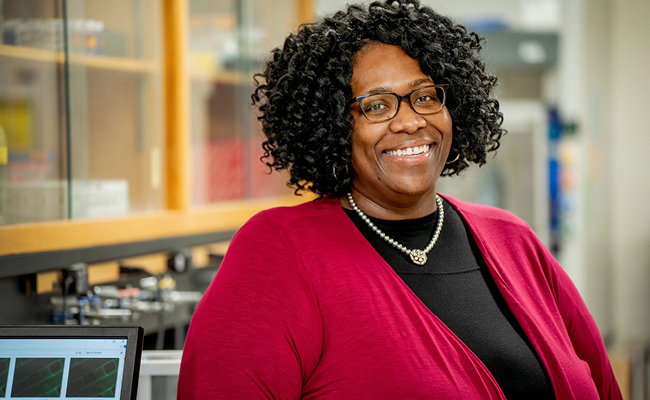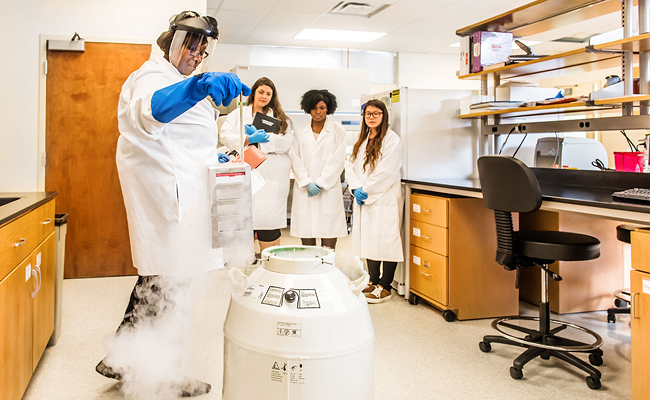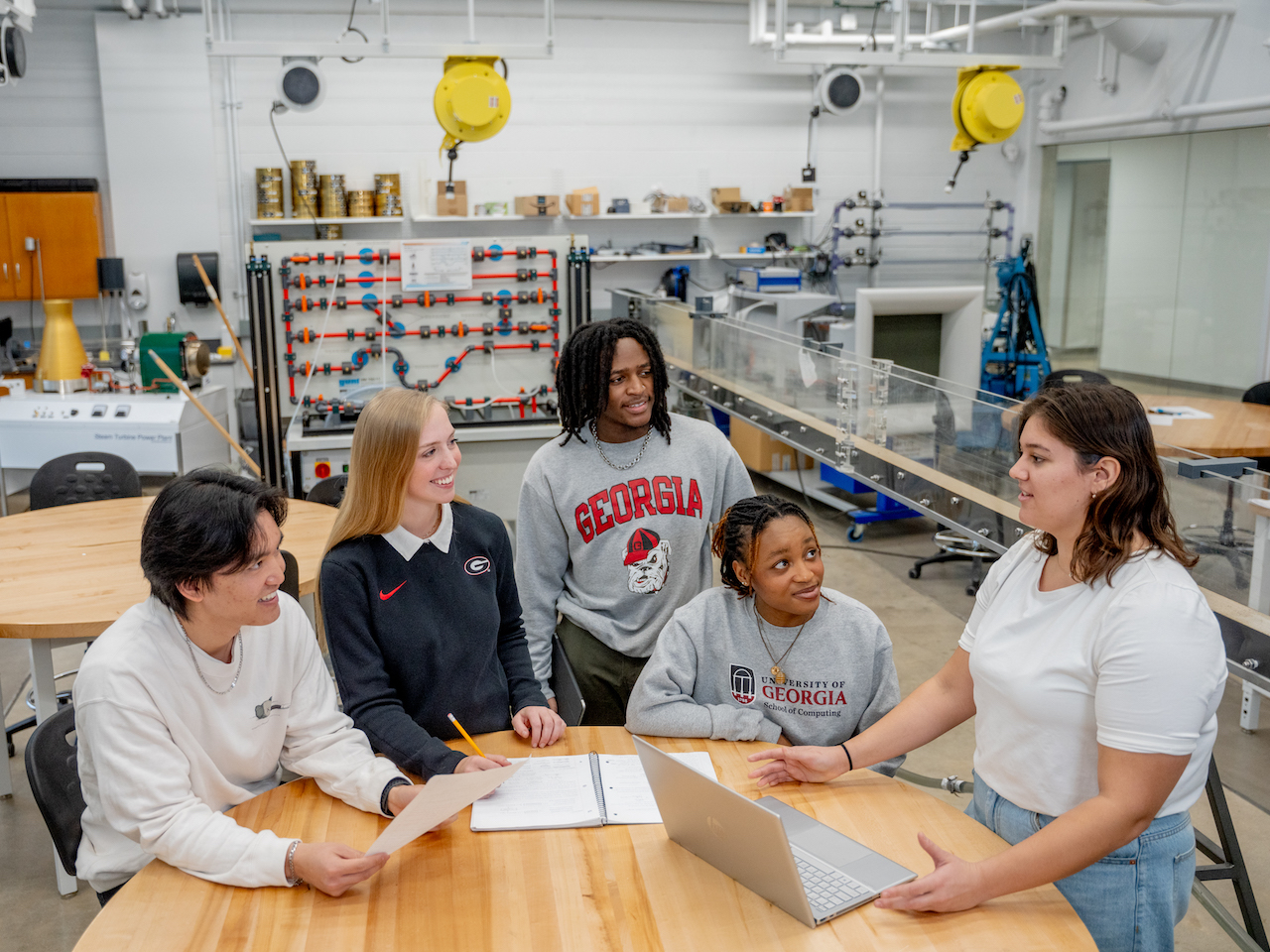
Cheryl Gomillion
Cheryl Gomillion is in the business of growing cultures.
First are the cell cultures she uses to engineer tissues for breast cancer research. Then there’s the culture of collaboration and learning in her lab, where she is cultivating the next generation of biomedical scientists.
Both cultures need to be fed and tended. Both require balancing the individual versus the collective. And both reward those who pay close attention.
“I tell my students to stay alert,” Gomillion said. “Stay open to the opportunities that come your way. You never know who you’re going to have a conversation with.”
A chance encounter
Growing up, Gomillion didn’t see herself becoming a professor. She was a strong student, but especially in her younger years, her teachers didn’t always know what to do with her. In her last years of elementary school, she entered the gifted and talented program and found her footing. As she progressed into middle and high school, she thought about becoming a pediatrician but told people she didn’t want to be in school forever.
She laughed when recalling that statement. “Don’t ever say you don’t want to do something,” she said. “Because you’ll probably wind up doing it.”
Many years of schooling did lie in her future—though not for pediatrics. A chance conversation with a faculty member led Gomillion to try her hand at lab research as an undergraduate at Clemson University. “It was all over from there,” she said.
Biomedical engineering allowed her to combine her interest in medicine with her newfound love of research. A first-generation college student and the first person in her family to attend graduate school, Gomillion went on to earn her M.S. and Ph.D. at Clemson and to hold postdoctoral appointments at the Yale School of Medicine and the University of Connecticut Health Center. She joined UGA’s College of Engineeringin 2015 and is an assistant professor in the School of Chemical, Materials and Biomedical Engineering. She is also a member of UGA’s Regenerative Bioscience Center.

As a first-generation college student and the first member of her family to attend graduate school, Gomillion is committed to training the next generation of biomedical engineers. In 2020 she received an NSF grant to study successful efforts to increase diversity in graduate engineering research labs. (Photo by Cassie Wright)
Understanding breast cancer metastases
Gomillion’s current research centers on engineering composite tissue systems for tissue replacements and pre-clinical tissue modeling. She is studying how tissue engineering can help us understand and treat breast cancer. Her interest started back in graduate school, when she began looking at how tissue engineering might aid breast reconstruction surgery. Over time, she started asking how similar processes might help explain and treat breast cancer metastases. She wanted to improve outcomes for those diagnosed with the disease, which runs in her family.
Today, the Gomillion lab is affiliated with CMaT, a National Science Foundation engineering research center for cell manufacturing technologies. While her team primarily designs systems specifically for modeling breast tissue, the methods and approaches utilized by the Gomillion lab hold broader implications for regenerative medicine and the field of cell therapies. Gomillion and her students have designed a modular batch recycle bioreactor for cell expansion, an invention currently moving through the patent process.
In engineering, cells are a product, manufactured and cultivated; as such, they need quality checks like any other product coming to market. Bioreactor technologies are used to culture cells in a controlled manner, helping to produce quality treatments and therapies. Gomillion and other CMaT researchers are working to answer the question: How do we create more efficient, reliable cells that can be used for cell therapy and other purposes? These cells can then be used for regenerating tissues such as bone, which is work also being performed in the Gomillion lab and supported by a grant from the Musculoskeletal Transplant Foundation.
Growing a diverse lab
Her efforts to advance scientific discovery cannot be separated from her commitment to training the next generation of biomedical engineers. A dedicated mentor, Gomillion devotes countless hours to her students. Someone once commented to her that her lab looked “different” from other labs, meaning more diverse. “That stuck with me,” she said. “If my lab can look different, why can’t other labs look different, too?”
In 2020, she received a National Science Foundation grant to study the success behind diversity in graduate engineering research labs. With support from UGA’s Engineering Education Transformation Institute and other mentors, Gomillion will look at specific research microcultures where underrepresented students do well, asking how and why diversity has taken hold in those locations.
Long term, she hopes to direct future STEM research toward expanding minority participation in graduate engineering programs. STEM departments and scientists need to be putting their own culture under the microscope, not just cell cultures, according to Gomillion. They need to be asking about equity, opportunity and inclusion in the lab setting and the entrepreneurial environment.
Gomillion’s own students have demonstrated a resilience and perseverance that she admires. They have navigated a national movement calling for racial justice as well as the ongoing pandemic. The lab had to shut down entirely for part of 2020; while it’s now back up and running, supply issues continue to plague the team. Some of Gomillion’s students contracted COVID-19, and she came down with the virus, as well. Together, they found ways to push ahead and keep the research going.
“Everyone needs something as an individual,” Gomillion says. “But collectively, as a group, we have to keep moving forward, even with disruption. Cells are living things; you have to feed and care for them to thrive, much like is needed for students.”
The most rewarding moments of her UGA career so far are the times she’s watched her students succeed and find their place in the world. Gomillion’s graduates are moving on to doctoral and medical school programs, engineering jobs and notable industry placements. One student who questioned her readiness recently applied for her dream position, with Gomillion’s encouragement. She landed the job and now is working in a co-op position at a lab at Bristol Myers Squibb, applying the skills learned from her UGA coursework and in Gomillion’s lab.
“Those moments remind me why I’m here,” Gomillion said. “At the end of the day, this work is relational. I tell my students to stay open to possibilities and opportunities. Things build on each other. You never know where a conversation might take you.”
It’s a vocation that goes well beyond what’s under the microscope.


